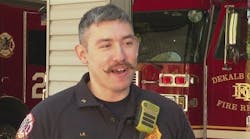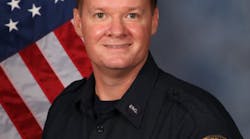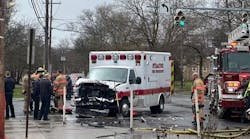Chimneys have a history of causing problems for firefighters. We have read National Institute for Occupational Safety and Health (NIOSH) Firefighter Fatality Investigation Reports that describe in great detail the issues of chimneys, steeples and related gravity-fighting structures that are a threat to firefighters. If you have not reviewed these, go to www.cdc.gov/niosh/fire and check out the hundreds of available reports. These reports are in-depth and state what happened and how it can be avoided.
A chimney collapsing at a single-family dwelling fire is the focus of this month's close call as submitted by the Little Rock, AR, Fire Department. The Little Rock Fire Department is comprised of 20 fire stations covering 122.31 square miles, protecting over 183,000 citizens. There are over 400 employees in the organization. Rhoda Mae Kerr, a fourth-generation firefighter, is the fire chief of the City of Little Rock.
Our sincere thanks to Chief Kerr, Battalion Chiefs Dave Wilson, Bryan Adkins and Doug Coney, and especially Fire Engineer Jason Weaver and the officers and members of the LRFD for their cooperation and willingness to share this information so other firefighters can learn.
This account is by Fire Engineer Jason Weaver:
It was about 2 A.M. on Nov. 15, 2006, when we received a call for a residential structure fire. It had been raining all night and now it was coming down in buckets. Dispatch stated that the house had been struck by lightning. We were the second engine company on scene; Engine 6 had arrived first and was already investigating. We stopped short at the plug and could see light smoke. Our captain assessed the situation and decided that we would go in and help Engine 6 make a quick knockdown, Engine 1 was right behind us and assumed water supply responsibilities.
While we were parking the apparatus, the wind shifted and pushed a large volume of smoke in our direction. We entered the front door of the structure with a 1¾-inch handline. We extinguished contents that had become involved on the way to the room that contained the bulk of the fire and heat. The room was cluttered and only partially involved, but the heat was intense. The contents were extinguished quickly, but the heat remained. Holes in the ceiling revealed that the fire was in the attic.
When we first placed our fire stream into the attic space through these voids, it seemed as if we were making headway. The volume of visible flame was reduced and the heat was slowly lessening. Then, all at once, the flames came back and the heat was even more intense. The fire had vented itself through the roof and the wind was blowing in, churning the fire. You could see the flames swirling around the attic and our fire stream was having no effect.
At this point, our incident commander ordered everyone out of the structure. We exited and my captain passed the nozzle to me and said that we were going to protect the exposure on the south side. We were to proceed to the rear of the structure and attempt to extinguish from that position. While moving into place, I came upon a short wall; it dropped off about three to four feet. I stopped to warn my captain and firefighter of this hazard and advised them that there were stairs. When I started to move forward again, I noticed that a coupling had become hung on a bush at the corner of the front porch. My captain ordered the firefighter to free the coupling. This placed him six to 10 feet away from me and the firefighter at the front corner of the structure 15 to 20 feet away.
Suddenly, I heard a loud crash followed by a rumble. The roof line and the wall were shaking so much that my first thought was that the roof had collapsed and the wall was going to fall. I tried to yell to warn my crew, but before I could get the words out, I saw a flash and my "lights" went out. I came to shortly after - my face ached and I could taste blood. I was scared. I just knew that if the wall hit me, it had to have crushed my captain. I tried to sit up to see if I could find him, but I couldn't. Then, I heard his voice, talking to me, and knew he was OK.
Still confused by all the commotion, it took me a little bit to realize that I was the one being rescued. I felt like I was going in and out at first and a lot of my memories are more like snapshots than fluid video. I can picture our truck company reaching down and grasping handfuls of my turnouts and carrying me out of the collapse zone. My face was still hurting, but when they picked me up, my left leg made me forget about my face. While they were carrying me, I found humor in the conversation about how heavy I was, about diets and other colorful comments, I thought to myself, only firefighters could be working under these conditions and still maintain a sense of humor.
It wasn't until I got to the hospital that I found out what had happened. A wall didn't fall on me - it was a chimney. After talking to the crews that were on the scene and looking at my equipment, it appears that the first piece to hit me was the largest section of the chimney. It came down on my helmet and hit me in the back. Then, smaller pieces fell, covering me. I was hanging halfway off the short wall balanced on my SCBA's air bottle. My captain jumped off the wall and positioned himself under me, while holding my shoulders up. He notified the incident commander that there was an injury and initiated the rescue.
I received a broken scapula, two broken ribs, a broken tibia, shattered fibula, a dislocated ankle and several facial lacerations along with miscellaneous bumps and bruises. I immediately went to surgery to close and repair the wounds on my face and head. Two weeks later, I had surgery to place a plate and screws in my leg and ankle. I'm also scheduled to have another surgery to repair my eyelid. I'm expecting to make a full recovery and look forward to returning to work.
I am more than certain that I would not be returning to work if I hadn't had on my PPE (personal protective equipment):
- My helmet took a big shot and did a great job protecting my head. Even though I wasn't on air, my airpack protected me; the bottle took some of the impact from the falling bricks and protected my spine. Wear all PPE!
- Be aware of your surroundings. Look up. During your initial size-up, look for any overhead hazards or anything that may become a hazard.
- Keep some distance between you and the involved structure. If possible, don't walk directly next to or under any part of the structure that is involved.
This joint account is by Battalion Chiefs Dave Wilson, the incident commander, and Battalion Chief Bryan Adkins, the safety officer:
Engine 6 responded to a report of a house struck by lightning at approximately 2 A.M. during a heavy rainstorm. On arrival, Engine 6 found fire showing through the southwest windows (C side). Engine 6 advised the next company to lay a five-inch supply line while Engine 6 used a 1¾-inch line for an interior attack through the front door (A side). On entering the structure, Engine 6 encountered two rooms on fire on the west end of house.
The incident commander (Battalion Chief 1) arrived moments after Engine 6 and found the same conditions as Engine 6. Engine 8 was ordered to assist Engine 6 with a second 1¾-inch line, being taken in shortly after. Truck 1 was ordered inside to assist in pulling ceilings. The fire extended to the attic, vented through the C-side gable and was pushed from the C side of attic to the A side by heavy winds. At this point, command ordered all units out of structure after approximately 15 minutes due to the extent of fire and roof conditions.
The safety officer (Battalion Chief 2) arrived within two minutes of command (Battalion Chief 1) and did a walk-around of the structure to check for hazards and ongoing operations. On the C side, fire was found to have broken through and venting out a window, impinging on the electric service lines to the house. Personnel were warned of the conditions and ordered not to enter any backyard and alley areas. Minutes later, the electric line broke and fell across a chain link fence and the alley at the rear of the house. Heavy smoke prevented us from seeing three-quarters of the roof, and weather conditions caused the smoke to bank down to ground level on the A and B sides to the street, obstructing the entire view of the house. A roll call was done upon all units being ordered out of the structure and to go into a defensive mode.
The chimney fell on Engine 8 during or immediately after the roll call. The cause of the chimney falling may have been a partial collapse of the roof in that area. The roof was obscured until this point by heavy smoke. The house had two chimneys, one on the south (B side) and one on the north (D side) that the safety officer did not see until the smoke lifted.
Shortly after the chimney collapsed, lightning hit one of our radio repeaters and the radios worked intermittently. The crews on scene immediately went to the aid of Engine 8, removed Engineer Weaver from the collapse area and rendered first aid. The incident commander ordered all personnel to move away from the structure until a new size-up was done.
The weather was the main contributor to driving the fire to spread once it reached the attic. The heavy rain kept the smoke from lifting above the roof of the house and blocked the view of the chimneys. The rain also kept the view of the houses nearby from being used. This is an older neighborhood with houses of similar design and construction that could have been looked to for chimneys and other features. The wind pushed the fire faster than it could be contained to one area of the attic. Lightning knocking out the radios caused problems with communications; sometimes we had none at all. The incident commander and safety officer had cell phones that could have been used had the situation arose.
One of the things that made a difference was that not only was Engineer Weaver wearing all of his PPE, he was wearing it correctly, as was the rest of his crew. Keeping crew integrity was a difference maker as well. Had his captain not been aware of where each member of his crew was at all times, the immediate help that Engineer Weaver received could have been delayed. Captain Eddie Tackett immediately radioed command of the situation and an ambulance was called for. We also conducted critical incident stress debriefing (CISD) during the next shift for all personnel who were at the scene.
The following comments and observations by Chief Goldfeder are based on communications with the writers and others:
The one thing that immediately stood out to me as I wrote this is that the Little Rock Fire Department treats a house struck by lightning as a structural fire. They should. It is! I wrote this as I listened to a nearby fire department send a lesser response to the same kind of call. They wait until they get there to see what it is. What it is? It is a structural fire until "we" get there and determine that it isn't - or is! LRFD gets it. Most fire department do. Some don't. The "let's check it out" or "not send so much equipment until we know we need it" can and has led to additional property destruction, injuries, and death to both civilians and firefighters.
Why not send a full structural response (whatever that means in your community based on the construction, occupancy, water supply, etc.) to a structure hit by lightning? There are loads of excuses, but the answer is that a full response is what the homeowner and the firefighters deserve. Send enough staffing and equipment to provide water, vent, force entry, search, stretch lines, rescue, attack the fire, manage command, safety and accountability in case it is needed, instead of getting there with a lesser response and then needing it. What if you get there and it is determined to be nothing? Send them home.
Other items worthy of consideration:
- LRFD sends a chief specifically assigned to safety on any structural-related incident.
- Protective clothing. Engineer Weaver is a living testimony in why we must wear our gear. No exposed skin. Soot on your skin causes cancer; it's been proven by the experts. Protect your skin from burns and soot. And wear your helmet with the strap.
- If there is any smoke, don't breathe it. Smoke is poison, even just a little. This stuff is death; sometimes sooner than later, but if there is any smoke, use your SCBA.
- Do what it takes before and during the incident to know what you and your firefighters are getting into. Pre-plan, even residential areas. Spend more time out of the firehouse than in. Know the neighborhoods and the structures in them.
- Gravity. As anything burns, gravity is forcing it to fall, from floors to ceilings to roofs to chimneys. Determine collapse zones and stay out of them. As pointed out, look up and continually perform your own size-ups and communicate relevant information.
- When command ordered companies out of the building, the companies left the building, as they should. Some interior crews from some fire departments may have argued or wanted "just a few more minutes." Wrong answer. When command orders us to get out, we need to do that.
- Radio systems. This is an issue for all fire departments. What system backups exist? What if the backup fails? How often are the backup systems tested? What procedures are to be followed by both dispatch personnel and fire personnel when the primary radio system fails? How do members know it failed before they need it? Does the fire department depend on a 9-5 radio technician? What do you do Sunday at 8 P.M. if it fails? What happens between the time the radio system fails and the time it is fixed? How will you communicate? How will calls be dispatched? With the complicated radio systems that exist these days, I can't emphasize the need to be able to answer these questions.
Like most incidents discussed in this column, the Little Rock Fire Department's close call could have happened to any of us. In this case, Fire Engineer Weaver wore his gear, had on his helmet and donned his SCBA. It mattered. It probably saved his life. Additionally, by sending a full response, resources were on the scene to manage the initial problem and the subsequent firefighter emergency. Compare this "simple" dwelling struck by lightning to the same call in your community? What would the response be? Thanks to the Little Rock Fire Department, we have another chance of not repeating history.
WILLIAM GOLDFEDER, EFO, a Firehouse contributing editor, is a 32-year veteran of the fire service. He is a deputy chief with the Loveland-Symmes Fire Department in Ohio, an ISO Class 2 and CAAS-accredited department. Goldfeder has been a chief officer since 1982, has served on numerous IAFC and NFPA committees, and is a past commissioner with the Commission on Fire Accreditation International. He is a graduate of the Executive Fire Officer Program at the National Fire Academy and is an active writer, speaker and instructor on fire service operational issues. Goldfeder and Gordon Graham host the free and noncommercial firefighter safety and survival website www.FirefighterCloseCalls.com. Goldfeder may be contacted at [email protected].





